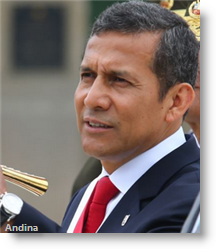 President Ollanta Humala is defending his administration’s handling of the economy, saying that his government hasn’t been put on “autopilot.”
President Ollanta Humala is defending his administration’s handling of the economy, saying that his government hasn’t been put on “autopilot.”
“We have never been on autopilot,” he said, according to business daily Gestion. “Autopilot would have been if we had the favorable winds there were in the previous five-year period, when Latin American growth was above 6% on average and we hadn’t started the National Plan for Production Diversification, because there was an autopilot.”
Humala was responding to criticism levied at his administration by economist Luis Carranza, a former Finance minister during the administration of Humala’s predecessor, Alan Garcia.
Peru’s economy posted robust growth during Garcia’s second term in office, from 2006 to 2011, driven by strong global demand for the country’s minerals.
A decline in demand for commodities from China, however, sent the price of raw materials like copper and oil tumbling over the past year, hurting the exports of resource-rich nations like Peru.
Last year, Peru’s economy grew just 2.4% compared to 5.8% in 2013. Government economists have said that the economy would likely rebound this year to about 4% growth, but business leaders say privately that this is highly unlikely.
On Wednesday, government statistics agency INEI said Peru’s economy expanded by just 0.94% in February, as construction sector activity contracted by its biggest rate since 2011. The economy grew by 1.7% in January.
Economists like Carranza blame Humala’s government for much of the slowdown, saying that the administration hasn’t done enough to promote investments in the face of extensive red-tape and social conflicts.






It would not be realistic for Peru to have 4% growth this year or in 2016. The demand for natural resources is in a major slump, not to recover for at least several years. Peru has only it’s resources too sell, which is worth much less. Canada, Russia and Australia have a lot less revenue coming into to government . Almost every investment manager around the world are predicting a major recession starting later this year, a lot of debt must be written off.
It would have been helpful if the opposition parties wouldn’t keep recycling the cabinet ministers in Lima every few months, with non confidence votes. I understand they are positioning themselves for the 2016 election cycle, but the end result of this will result in a much worse economy by the time they take office in 2016. Peru has a fairly dysfunctional government, with a boom and bust type economy based on only natural resources. Tourism could provide a greater boost to the local economy, but the construction of new infrastructure to open up new historical sites is only talked about. Most of the revenue from existing sites like Machu Picchu goes to Lima, or just gets lost in the poor accounting systems.
In the town here in Peru where i live, the level of economic activity has slowed down since january. I know of a lot of local men who can no longer find any work. The next door neighbor who sells Chicha beer, doesn’t have many customers lately. The place was usually full mid day with local construction workers. You know the economy is not so good, when the locals can not afford their mid day corn beer.
Peruvians are a very intelligent, hard working people. This country could be so much better , if it had all of the political parties working for the improvement and diversification of the economy.
Excellent article, but I would add that many Peruvians are under-educated because of poor public primary and secondary school education. Peruvians should be using state of the art equipment to enhance productivity, but unfortunately,in the short run, the unemployment rate would increase.